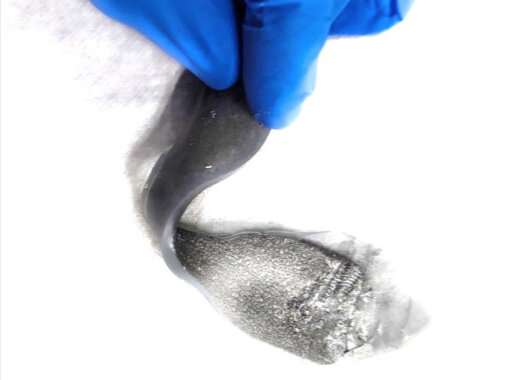Liquid metal composites enable soft, stretchable circuits that are electrically conductive, mechanically self-healing, and highly adaptable. Credit: Soft Machines Lab, Carnegie Mellon University
Soft, stretchable materials that are also electrically conductive are hard to come by. It's even harder to create a circuit that withstands damage, going as far as to heal itself. For Carnegie Mellon University researchers, however, these kinds of innovations are just another day at the office.
In two recently published papers, teams of CMU researchers made strides in wearable electronics and other soft machines. Carmel Majidi's Soft Machines Lab (SML) has long been working in this area, and these two papers reflect that.
Previously in 2018, Majidi, an associate professor of mechanical engineering, and his team created a circuit that was able to electrically heal itself—that is, it could continue to function even after the main paths had been cut or damaged. Now, they have created a material made with liquid metal that is also able to physically repair damage. When two pieces of electrical liquid metal composites are placed together, they can fuse together in the same way that skin heals after a cut. This innovation allows circuits to withstand more damage because they can simply repair it.
SML achieved these advancements using a liquid metal made of a gallium and indium alloy. This metal is safer than other liquid metals like mercury, authors say. These discoveries allow the technology to be expanded to other polymers, including gels. This widens the range—and effect—of their research. In fact, circuits made with liquid metals can be erased and re-drawn, making them highly adaptable.
These new materials can also be 3-D printed. Sarah Bergbreiter, a professor of mechanical engineering, worked with Majidi and SML to print these materials using a new manufacturing process. Creating 3-D structures of these self-healing and re-writable circuits will widely expand the range of applications.
Soft composites that use droplets of gallium-based liquid metal have the potential for transformative impact in multifunctional material engineering. Credit: Soft Machines Lab, Carnegie Mellon University
One such application is energy harvesting. Energy can be generated using electricity from contact between two surfaces. Imagine, for example, the electricity that makes your hair stand up when you rub a balloon against it. This same principle can be applied to wearable electronics, allowing them to harvest energy from human motion.
Though the theoretical foundation is there, this is the first time anyone has been able to make it work using the composite. What's more, liquid metals are highly conductive, so they can easily produce large amounts of energy. And, because the electronics are soft and stretchable, they can readily be integrated into clothing.
When Majidi's team added the material into a pair of sports shorts, they were able to harvest enough energy from the wearer's movement to power a hygro-thermometer sensor with digital display (a small wearable computing device).
Applications of this research are far-reaching. Authors say its uses could include bio-inspired robotics, human-machine interaction, wearable computing, and solar cells. These soft robotics will be highly adaptable and durable, allowing for a wide range of applications.
The paper, titled "Controlled Assembly of Liquid Metal Inclusions as a General Approach for Multifunctional Composites," was published in Advanced Materials.
More information: Michael J. Ford et al. Controlled Assembly of Liquid Metal Inclusions as a General Approach for Multifunctional Composites, Advanced Materials (2020). DOI: 10.1002/adma.202002929
Chengfeng Pan et al. Ultrastretchable, Wearable Triboelectric Nanogenerator Based on Sedimented Liquid Metal Elastomer Composite, Advanced Materials Technologies (2020). DOI: 10.1002/admt.202000754
Journal information: Advanced Materials
























